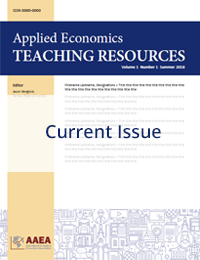Research Article
Job Attribute Preferences of Undergraduate Agricultural Majors—Do They Match with Careers in Grain Merchandising?
Keith D. Harris(a) and Brian C. Briggeman(a)
(a)Kansas State University
JEL Codes: A22, Q10, Q13
Keywords: Conjoint survey, grain merchandising, job preferences, willingness to accept
First Published Online: November 30, 2022
Volume 1, Issue 1
Abstract
The purpose of this study is to gain a better understanding of student job attribute preferences for grain merchandising careers. Undergraduate students in the College of Agriculture at Fort Hays State University and Kansas State University responded to a choice-based conjoint survey that captures students’ expectations about grain merchandising careers. Parameter estimates from a conditional alternative specific constants logit model are used to estimate willingness to accept changes in salary for preferred job attributes. Results suggest that students have strong preferences for working in rural locations and working at smaller companies and have professional growth opportunities. The students exhibited less of a preference for frequent performance feedback and oral communication, and a focus on risk management and analysis. These results should inform faculty advisors of the important attributes of grain merchandising and help agribusinesses to improve employee recruitment techniques and employee retention.
References
Anderson, E. 1985. “The Salesperson as Outside Agent or Employee: A Transaction Cost Analysis.” Marketing Science 4(3):234–254.
Barber, A.E., M.J. Wesson, Q.M. Roberson, and M.S. Taylor. 1999. “A Tale of Two Job Markets: Organizational Size and Its Effects on Hiring Practices and Job Search Behavior.” Personnel Psychology 52:841–867.
Barney, J. 1991. “Firm Resources and Sustained Competitive Advantage.” Journal of Management 17(1):99–120.
Becker, G.S. 1962. “Investment in Human Capital: A Theoretical Analysis.” Journal of Political Economy 70(5), Part 2:9–49.
Boyer, T.A., B.C. Briggeman, and F.B. Norwood. 2009. “Demand for Multimedia in the Classroom.” Journal of Agricultural and
Applied Economics 4:791–808.
Coase, R.H. 1937. “The Nature of the Firm.” Economica 16:386–405.
Garavan, T.N., M. Morley, P. Gunnigle, and E. Collins. 2001. “Human Capital Accumulation: The Role of Human Resource Development.” Journal of European Industrial Training 25(2/3/4):48–68.
Gracia, A., M.L. Loureiro, and R.M. Nayga Jr. 2009. “Consumers’ Valuation of Nutritional Information: A Choice Experiment Study.” Food Quality and Preference 20(7):463–471.
Greszki, R., M. Meyer, and H. Schoen. 2015. “Exploring the Effects of Removing ‘Too Fast’ Responses and Respondents from Web Surveys.” Public Opinion Quarterly 79(2):471–503.
Hoffman, S.D., and G.J. Duncan. 1988. “Multinomial and Conditional Logit Discrete-Choice Models in Demography.”
Demography 25:415–427.
Howe, N., and W. Strauss. 2000. Millennials Rising: The Next Great Generation. New York: Vintage.
Ibnu, M., P. Glasbergen, A. Offermans, and B. Arifin. 2015. “Farmer Preferences for Coffee Certification: A Conjoint Analysis of the Indonesian Smallholders.” Journal of Agricultural Science 7(6):20.
Johnson, F.R., E. Lancsar, D. Marshall, V. Kilambi, A. Mühlbacher, D. Regier, B. Bresnahan, B. Kanninen, and J. Bridges. 2013. “Constructing Experimental Designs for Discrete-Choice Experiments: Report of the ISPOR Conjoint Analysis Experimental Design Good Research Practices Task Force.” Value in Health 16(1):3–13.
Kliethermes, B.J., J.L. Parcell, and J.R.V. Franken. 2011. “What to Teach Future Commodity Merchandisers: A Survey of Skills
and Needs.” NACTA Journal 55(3):19–27.
Kuhfeld, W.F., R.D. Tobias, and M. Garratt. 1994. “Efficient Experimental Design with Marketing Research Applications.” Journal
of Marketing Research 31(4):545–557.
Lancaster, K.J. 1966. “A New Approach to Consumer Theory.” Journal of Political Economy 74(2):132–157.
Lancsar, E., and E. Savage. 2004. “Deriving Welfare Measures From Discrete Choice Experiments: Inconsistency Between Current Methods and Random Utility and Welfare Theory.” Health Economics 9:901–907.
Marchant, M.A., and L. Zepeda. 1995. “The Agricultural Economics Profession at the Crossroads: Survey Results of Faculty
Salary, Employment, and Hiring Prospects.” American Journal of Agricultural Economics 77(5):1322–1328.
McFadden, D. 1974. “The Measurement of Urban Travel Demand.” Journal of Public Economics 3(4):303–328.
McGraw, K., J.S. Popp, B.L. Dixon, and D.J. Newton. 2012. “Factors Influencing Job Choice among Agricultural Economics
Professionals.” Journal of Agricultural and Applied Economics 44(2):251–265.
Meyerding, S.G.H. 2018. “Job Preferences of Agricultural Students in Germany: A Choice-Based Conjoint Analysis for Both Genders.” International Food and Agribusiness Management Review 21(2):219–236.
Penrose, E.T. 1959. The Theory of the Growth of the Firm. New York: Oxford University Press.
Ryan, M., K. Gerard, and M. Amaya-Amaya. 2008. “Discrete Choice Experiments in a Nutshell.” In Using Discrete Choice Experiments to Value Health and Health Care. Dordrecht: Springer, pp. 13–46.Page | 17 Volume 1, Issue 1, June 2019
Schultz, T.W. 1970. “The Reckoning of Education as Human Capital.” In Education, Income, and Human Capital. Cambridge MA: National Bureau of Economic Research, pp. 297–306.
Smith, P.A.C. 1998. “Systemic Knowledge Management: Managing Organizational Assets for Competitive Advantage.” Journal of Systemic Knowledge Management 4:12–24.
Wachenheim, C.J., and W.C. Lesch. 2004. “US Executives’ Views on International Agribusiness Education in the United States: An IAMA Membership Survey.” International Food and Agribusiness Management Review 7(1):42–59.
Walton, S.V., and J.N.D Gupta. 1999. “Electronic Data Interchange for Process Change in an Integrated Supply Chain.” International Journal of Operations & Production Management 19(4):372–388.
Articles in this issue
Job Attribute Preferences of Undergraduate Agricultural Majors—Do They Match with Careers in Grain Merchandising?
Keith D. Harris and Brian C. Briggeman
Calculating and Interpreting Percentage Changes for Economic Analysis
Matthew A. Andersen
Assessing Student Learning Using a Digital Grading Platform
Andrew W. Stevens
Enhancing the Teaching of Product Substitutes/Complements: A Pedagogical Note on Diversion Ratios
Oral Capps, Jr. and Senarath Dharmasena
Teaching Undergraduate Economics: Emphasize Early the Meaning of Vertical Distances and of Their Summation Over Quantities
Matthew G. Interis
Occupational Health and Safety Issues at Agribusiness Retailers
Erik Hanson and Michael Boland
Let's take a moment to celebrate great teaching!
James A. Sterns
Moneyball in the Academy: Whiffing on the Quality of Education?
Paul N. Wilson


